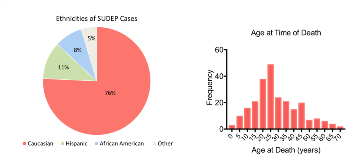The North American SUDEP Registry (NASR): Preliminary Descriptive Analysis of SUDEP Cases
Abstract number :
1.425
Submission category :
16. Epidemiology
Year :
2018
Submission ID :
489385
Source :
www.aesnet.org
Presentation date :
12/1/2018 6:00:00 PM
Published date :
Nov 5, 2018, 18:00 PM
Authors :
Chloe Verducci, NYU Langone Comprehensive Epilepsy Center; Fizza Hussain, NYU Langone Comprehensive Epilepsy Center; Daniel Friedman, NYU Langone School of Medicine; and Orrin Devinsky, NYU Langone School of Medicine
Rationale: The North American SUDEP Registry (NASR) is a large-scale, retrospective repository of medical records and biospecimens gathered to study possible causes and risk factors leading to sudden unexpected death in epilepsy (SUDEP), one of the leading causes of death in people with epilepsy (PWE). Methods: Starting from June 2011, NASR has enrolled decedents with epilepsy, living first degree relatives with epilepsy, and unrelated syndrome-specific living controls. We compiled an extensive database comprised of each case’s clinical history, including EEGs, MRIs, death investigation reports, and brain and DNA donations, where available. A telephone interview was conducted with decedents’ next of kin to obtain details about social history, family history, medication history (including compliance), and seizure semiology to better define clinical features that may be related to SUDEP risk. All enrolled decedents underwent adjudication for seizure types, EEG findings, MRI findings and SUDEP classification by two epileptologists based on decedent’s clinical history, medical records, circumstances of death, autopsy and toxicology findings, according to the criteria proposed by Nashef and colleagues (2011). Cases where there was disagreement underwent review by a consensus panel of 3-5 epileptologists, SUDEP researchers, and forensic pathologists. Here, we report on the first 250 definite SUDEP, definite SUDEP plus, and probable SUDEP cases enrolled in NASR. Results: The median age at death of SUDEP cases was 26 years; range 1-70 years. 38.4% (n=96) were female, 75.2% (n=185) were Caucasian, 9.8% (n=24) Hispanic, and 9.8% (n=24) were African American. Of the cases where sufficient detail was available to classify seizure, epilepsy type and seizure frequency (n=151), 31% had a history of primarily generalized onset (n=47) and 44.4% had focal to bilateral (n=67) tonic-clonic seizures. 24.5% (37/151) had no history of generalized tonic-clonic seizures. Death was witnessed in only 9% (n=22) of SUDEP cases. Among the unwitnessed deaths, 50.4% (n=126) were found prone, 59% (n=128) had evidence of a terminal seizure (tongue/cheek bite, incontinence, etc.). CPR was performed on 47.2% (n=118) decedents upon discovery. Only 67.9% (n=169) had a full autopsy performed. The next of kin donated brain tissue for 99 decedents and DNA for 107 decedents. Conclusions: In this self-referred clinical and biospecimen registry, the median age, seizure history and death circumstances were similar to prior population and clinic-based studies of SUDEP, suggesting that the SUDEP cases enrolled in NASR are representative of some of the diverse aspects of SUDEP presentation. Analysis of the materials collected through the registry will allow us to draw generalizable conclusions about SUDEP mechanisms. We aim to make NASR material to qualified researchers studying SUDEP and epilepsy to accelerate understanding of this devastating consequence of epilepsy. Funding: Sources of Funding: Finding a Cure for Epilepsy and Seizures (FACES), Lundbeck, and the American Epilepsy Society

.tmb-.png?Culture=en&sfvrsn=74fbfe9e_0)